Reactivity of Open-Shell Metallofullerene Anions: Synthesis, Crystal Structures, and Electrochemical Properties of Benzylated Gd@C2v-C82
Abstract
:1. Introduction
2. Results and Discussion
3. Materials and Methods
3.1. Synthesis of 2a, 2b, and 2d
3.2. Single Crystal X-ray Crystallography
3.3. Computational Details
4. Conclusions
Author Contributions
Funding
Data Availability Statement
Conflicts of Interest
References
- Popov, A.A.; Yang, S.; Dunsch, L. Endohedral fullerenes. Chem. Rev. 2013, 113, 5989–6113. [Google Scholar] [CrossRef] [PubMed]
- Dunsch, L.; Yang, S. Metal nitride cluster fullerenes: Their current state and future prospects. Small 2007, 3, 1298–1320. [Google Scholar] [CrossRef] [PubMed]
- Yang, S.; Wei, T.; Jin, F. When metal clusters meet carbon cages: Endohedral clusterfullerenes. Chem. Soc. Rev. 2017, 46, 5005–5058. [Google Scholar] [CrossRef]
- Li, F.-F.; Rodríguez-Fortea, A.; Poblet, J.M.; Echegoyen, L. Reactivity of Metallic Nitride Endohedral Metallofullerene Anions: Electrochemical Synthesis of a Lu3N@Ih-C80 derivative. J. Am. Chem. Soc. 2011, 133, 2760–2765. [Google Scholar] [CrossRef]
- Li, F.-F.; Rodríguez-Fortea, A.; Peng, P.; Campos Chavez, G.A.; Poblet, J.M.; Echegoyen, L. Electrosynthesis of Sc3N@Ih-C80 methano derivative from trianionic Sc3N@Ih-C80. J. Am. Chem. Soc. 2012, 134, 7480–7487. [Google Scholar] [CrossRef] [PubMed]
- Duong, H.M.; Myint, S.M.; Tran, T.Q.; Le, D.K. Chapter 6—Post-spinning treatments to carbon nanotube fibers. In Carbon Nanotube Fibers and Yarns; Miao, M., Ed.; Woodhead Publishing: Soston, UK, 2020; pp. 103–134. [Google Scholar] [CrossRef]
- Paukov, M.; Kramberger, C.; Begichev, I.; Kharlamova, M.; Burdanova, M. Functionalized Fullerenes and Their Applications in Electrochemistry, Solar Cells, and Nanoelectronics. Materials 2023, 16, 1276. [Google Scholar]
- Serda, M.; Korzuch, J.; Dreszer, D.; Krzykawska-Serda, M.; Musioł, R. Interactions between modified fullerenes and proteins in cancer nanotechnology. Drug Discov. Today 2023, 28, 103704. [Google Scholar] [CrossRef]
- Grebowski, J.; Litwinienko, G. Metallofullerenols in biomedical applications. Eur. J. Med. Chem. 2022, 238, 114481. [Google Scholar] [CrossRef]
- Chai, Y.; Guo, T.; Jin, C.; Haufler, R.E.; Chibante, L.P.; Fure, J.; Wang, L.V.; Alford, J.M.; Smalley, R.E. Fullerenes with Metals Inside. J. Phys. Chem. 1991, 95, 7564–7568. [Google Scholar]
- Maeda, Y.; Tsuchiya, T.; Lu, X.; Takano, Y.; Akasaka, T.; Nagase, S. Current progress on the chemical functionalization and supramolecular chemistry of M@C82. Nanoscale 2011, 3, 2421–2429. [Google Scholar]
- Fang, H.; Cong, H.; Suzuki, M.; Bao, L.; Yu, B.; Xie, Y.; Mizorogi, N.; Olmstead, M.M.; Balch, A.L.; Nagase, S.; et al. Regioselective Benzyl Radical Addition to an Open-Shell Cluster Metallofullerene. Crystallographic Studies of Cocrystallized Sc3C2@Ih-C80 and Its Singly Bonded Derivative. J. Am. Chem. Soc. 2014, 136, 10534–10540. [Google Scholar] [CrossRef]
- Bao, L.; Chen, M.; Pan, C.; Yamaguchi, T.; Kato, T.; Olmstead, M.M.; Balch, A.L.; Akasaka, T.; Lu, X. Crystallographic Evidence for Direct Metal–Metal Bonding in a Stable Open-Shell La2@Ih-C80 Derivative. Angew. Chem. Int. Ed. 2016, 55, 4242–4246. [Google Scholar] [CrossRef]
- Huang, H.; Zhang, L.; Gao, X.J.; Guo, X.; Cui, R.; Xu, B.; Dong, J.; Li, Y.; Gan, L.; Chang, F. Regioselective Polyamination of Gd@C2v(9)-C82 and non-high performance liquid chromatography rapid separation of Gd@C82(morpholine)7. Chem. Mater. 2018, 30, 64–68. [Google Scholar] [CrossRef]
- Liu, Z.; Huang, H.; Wang, Y.-X.; Dong, B.-W.; Sun, B.-Y.; Jiang, S.-D.; Gao, S. Amination of the Gd@C82 endohedral fullerene: Tunable substitution effect on quantum coherence behaviors. Chem. Sci. 2020, 11, 10737–10743. [Google Scholar] [CrossRef]
- Kandrashkin, Y.E.; Zaripov, R.B.; Liu, F.; Büchner, B.; Kataev, V.; Popov, A.A. Temperature-dependent dynamics of endohedral fullerene Sc2@C80(CH2Ph) studied by EPR spectroscopy. Phys. Chem. Chem. Phys. 2021, 23, 18206–18220. [Google Scholar] [CrossRef]
- Kandrashkin, Y.E.; Zaripov, R.B. Scandium dimetallofullerene with a single-electron metal–metal bond as a spectroscopic ruler for EPR measurements. Phys. Chem. Chem. Phys. 2022, 24, 19743–19752. [Google Scholar] [CrossRef] [PubMed]
- Xu, D.; Jiang, Y.; Wang, Y.; Zhou, T.; Shi, Z.; Omachi, H.; Shinohara, H.; Sun, B.; Wang, Z. Turning on the Near-Infrared Photoluminescence of Erbium Metallofullerenes by Covalent Modification. Inorg. Chem. 2019, 58, 14325–14330. [Google Scholar] [CrossRef] [PubMed]
- Sun, D.; Huang, H.; Yang, S.; Liu, Z.; Liu, S. Synthesis and characterization of a water-soluble endohedral metallofullerol. Chem. Mater. 1999, 11, 1003–1006. [Google Scholar] [CrossRef]
- Li, T.; Dorn, H.C. Biomedical applications of metal-encapsulated fullerene nanoparticles. Small 2017, 13, 1603152. [Google Scholar] [CrossRef] [PubMed]
- Li, L.; Zhen, M.; Wang, H.; Sun, Z.; Jia, W.; Zhao, Z.; Zhou, C.; Liu, S.; Wang, C.; Bai, C. Functional Gadofullerene Nanoparticles Trigger Robust Cancer Immunotherapy Based on Rebuilding an Immunosuppressive Tumor Microenvironment. Nano Lett. 2020, 20, 4487–4496. [Google Scholar] [CrossRef]
- Jia, W.; Li, X.; Zhang, T.; Wang, C.; Zhen, M. Efficiently normalizing leukopoiesis by gadofullerene nanoparticles to ameliorate radiation-triggered myelosuppression. J. Mater. Chem. B 2023, 11, 7401–7409. [Google Scholar] [CrossRef] [PubMed]
- Zhou, C.; Zhen, M.; Yu, M.; Li, X.; Yu, T.; Liu, J.; Jia, W.; Liu, S.; Li, L.; Li, J.; et al. Gadofullerene inhibits the degradation of apolipoprotein B100 and boosts triglyceride transport for reversing hepatic steatosis. Sci. Adv. 2020, 6, eabc1586. [Google Scholar] [CrossRef] [PubMed]
- Cagle, D.W.; Kennel, S.J.; Mirzadeh, S.; Alford, J.M.; Wilson, L.J. In vivo studies of fullerene-based materials using endohedral metallofullerene radiotracers. Proc. Natl. Acad. Sci. USA 1999, 96, 5182–5187. [Google Scholar] [CrossRef] [PubMed]
- Hino, S.; Umishita, K.; Iwasaki, K.; Miyazaki, T.; Miyamae, T.; Kikuchi, K.; Achiba, Y. Photoelectron spectra of metallofullerenes, Gd@C82 and La2@C80: Electron transfer from the metal to the cage. Chem. Phys. Lett. 1997, 281, 115–122. [Google Scholar] [CrossRef]
- Hino, S.; Iwasaki, K.; Umishita, K.; Miyazaki, T.; Kikuchi, K.; Achiba, Y. Photoelectron spectra of metal fullerenes: Are metal fullerenes molecular crystals or not? J. Electron. Spectrosc. Relat. Phenom. 1996, 78, 493–496. [Google Scholar] [CrossRef]
- Suzuki, T.; Kikuchi, K.; Oguri, F.; Nakao, Y.; Suzuki, S.; Achiba, Y.; Yamamoto, K.; Funasaka, H.; Takahashi, T. Electrochemical properties of fullerenolanthanides. Tetrahedron 1996, 52, 4973–4982. [Google Scholar] [CrossRef]
- Takano, Y.; Aoyagi, M.; Yamada, M.; Nikawa, H.; Slanina, Z.; Mizorogi, N.; Ishitsuka, M.O.; Tsuchiya, T.; Maeda, Y.; Akasaka, T. Anisotropic magnetic behavior of anionic Ce@C82 carbene adducts. J. Am. Chem. Soc. 2009, 131, 9340–9346. [Google Scholar] [CrossRef]
- Li, J.; Wang, T.; Feng, Y.; Zhang, Y.; Zhen, M.; Shu, C.; Jiang, L.; Wang, Y.; Wang, C. A water-soluble gadolinium metallofullerenol: Facile preparation, magnetic properties and magnetic resonance imaging application. Dalton Trans. 2016, 45, 8696–8699. [Google Scholar] [CrossRef]
- Kato, H.; Kanazawa, Y.; Okumura, M.; Taninaka, A.; Yokawa, T.; Shinohara, H. Lanthanoid endohedral metallofullerenols for MRI contrast agents. J. Am. Chem. Soc. 2003, 125, 4391–4397. [Google Scholar] [CrossRef]
- Kang, S.-G.; Araya-Secchi, R.; Wang, D.; Wang, B.; Huynh, T.; Zhou, R. Dual inhibitory pathways of metallofullerenol Gd@C82(OH)22 on matrix metalloproteinase-2: Molecular insight into drug-like nanomedicine. Sci. Rep. 2014, 4, 4775. [Google Scholar] [CrossRef]
- Chen, S.H.; Kang, S.-g.; Luo, J.; Zhou, R. Charging nanoparticles: Increased binding of Gd@C82(OH)22 derivatives to human MMP-9. Nanoscale 2018, 10, 5667–5677. [Google Scholar] [CrossRef] [PubMed]
- Deng, R.; Wang, Y.; Zhen, M.; Li, X.; Zou, T.; Li, J.; Yu, T.; Zhou, Y.; Lu, Z.; Xu, H.; et al. Real-time monitoring of tumor vascular disruption induced by radiofrequency assisted gadofullerene. Sci. China Mater. 2018, 61, 1101–1111. [Google Scholar] [CrossRef]
- Zhang, Y.; Shu, C.; Zhen, M.; Li, J.; Yu, T.; Jia, W.; Li, X.; Deng, R.; Zhou, Y.; Wang, C. A novel bone marrow targeted gadofullerene agent protect against oxidative injury in chemotherapy. Sci. China Mater. 2017, 60, 866–880. [Google Scholar] [CrossRef]
- Lucas, D.; Scheiermann, C.; Chow, A.; Kunisaki, Y.; Bruns, I.; Barrick, C.; Tessarollo, L.; Frenette, P.S. Chemotherapy-induced bone marrow nerve injury impairs hematopoietic regeneration. Nat. Med. 2013, 19, 695–703. [Google Scholar] [CrossRef] [PubMed]
- Li, X.; Zhen, M.; Zhou, C.; Deng, R.; Yu, T.; Wu, Y.; Shu, C.; Wang, C.; Bai, C. Gadofullerene nanoparticles reverse dysfunctions of pancreas and improve hepatic insulin resistance for type 2 diabetes mellitus treatment. ACS Nano 2019, 13, 8597–8608. [Google Scholar] [CrossRef]
- Jia, W.; Zhen, M.; Li, L.; Zhou, C.; Sun, Z.; Liu, S.; Zhao, Z.; Li, J.; Wang, C.; Bai, C. Gadofullerene nanoparticles for robust treatment of aplastic anemia induced by chemotherapy drugs. Theranostics 2020, 10, 6886–6897. [Google Scholar] [CrossRef]
- Sun, B.; Li, M.; Luo, H.; Shi, Z.; Gu, Z. Electrochemical properties of metallofullerenes and their anions. Electrochim. Acta 2002, 47, 3545–3549. [Google Scholar] [CrossRef]
- Sun, B.; Luo, H.; Shi, Z.; Gu, Z. Electrochemical properties of Gd@C82 and its anions. Electrochem. Commun. 2002, 4, 47–49. [Google Scholar] [CrossRef]
- Takano, Y.; Ishitsuka, M.O.; Tsuchiya, T.; Akasaka, T.; Kato, T.; Nagase, S. Retro-reaction of singly bonded La@C82 derivatives. Chem. Commun. 2010, 46, 8035–8036. [Google Scholar] [CrossRef]
- Zhao, Y.-l.; Zhou, Q.; Lian, Y.-f.; Yu, H.-t. Molecular structures of Pr@C72 and Pr@C72(C6H3Cl2): A combined experimental–theoretical investigation. RSC Adv. 2015, 5, 97568–97578. [Google Scholar] [CrossRef]
- Kareev, I.E.; Bubnov, V.P.; Fedutin, D.N.; Yagubskii, E.B.; Lebedkin, S.F.; Laukhina, E.E.; Kuvychko, I.V.; Strauss, S.H.; Boltalina, O.B. Trifluoromethylation of Endohedral Metallofullerenes M@C82(M = Y, Ce): Synthesis, Isolation and Structure. In Hydrogen Materials Science and Chemistry of Carbon Nanomaterials; Springer: Dordrecht, The Netherlands, 2007; pp. 235–242. [Google Scholar]
- Han, X.; Xin, J.; Yao, Y.; Liang, Z.; Qiu, Y.; Chen, M.; Yang, S. Capturing the Long-Sought Dy@C2v(5)-C80 via Benzyl Radical Stabilization. Nanomaterials 2022, 12, 3291. [Google Scholar] [CrossRef] [PubMed]
- Huang, H.; Liu, Z.; Zhang, L.; Guo, X.; Cui, R.; Dong, J.; Chang, F.; Jiang, S.; Gao, S.; Sun, B. Paramagnetic properties adjustment for Gd@C2v(9)-C82 by regioselective multi-amination. Carbon 2020, 158, 320–326. [Google Scholar] [CrossRef]
- Shu, C.; Slebodnick, C.; Xu, L.; Champion, H.; Fuhrer, T.; Cai, T.; Reid, J.E.; Fu, W.; Harich, K.; Dorn, H.C.; et al. Highly Regioselective Derivatization of Trimetallic Nitride Templated Endohedral Metallofullerenes via a Facile Photochemical Reaction. J. Am. Chem. Soc. 2008, 130, 17755–17760. [Google Scholar] [CrossRef] [PubMed]
- Li, F.-F.; Pinzón, J.R.; Mercado, B.Q.; Olmstead, M.M.; Balch, A.L.; Echegoyen, L. [2 + 2] Cycloaddition Reaction to Sc3N@Ih-C80. The Formation of Very Stable [5,6]- and [6,6]-Adducts. J. Am. Chem. Soc. 2011, 133, 1563–1571. [Google Scholar] [CrossRef]
- Cai, T.; Slebodnick, C.; Xu, L.; Harich, K.; Glass, T.E.; Chancellor, C.; Fettinger, J.C.; Olmstead, M.M.; Balch, A.L.; Gibson, H.W.; et al. A Pirouette on a Metallofullerene Sphere: Interconversion of Isomers of N-tritylpyrrolidino Ih Sc3N@C80. J. Am. Chem. Soc. 2006, 128, 6486–6492. [Google Scholar] [CrossRef]
- Chen, M.; Guan, R.; Li, B.; Yang, L.; Niu, C.; Jin, P.; Wang, G.-W.; Yang, S. Anomalous Cis-Conformation Regioselectivity of Heterocycle-Fused Sc3N@D3h-C78 Derivatives. Angew. Chem. Int. Ed. 2021, 60, 7880–7886. [Google Scholar] [CrossRef]
- Hu, Y.; Yao, Y.-R.; Liu, X.; Yu, A.; Xie, X.; Abella, L.; Rodríguez-Fortea, A.; Poblet, J.M.; Akasaka, T.; Peng, P.; et al. Unexpected formation of 1,2- and 1,4-bismethoxyl Sc3N@Ih-C80 derivatives via regioselective anion addition: An unambiguous structural identification and mechanism study. Chem. Sci. 2021, 12, 8123–8130. [Google Scholar] [CrossRef]
- Xu, Y.-Y.; Tian, H.-R.; Li, S.-H.; Chen, Z.-C.; Yao, Y.-R.; Wang, S.-S.; Zhang, X.; Zhu, Z.-Z.; Deng, S.-L.; Zhang, Q.; et al. Flexible decapyrrylcorannulene hosts. Nat. Commun. 2019, 10, 485. [Google Scholar] [CrossRef]
- Chen, M.; Zhao, Y.; Jin, F.; Li, M.; Guan, R.; Xin, J.; Yao, Y.-R.; Zhao, X.; Wang, G.-W.; Zhang, Q.; et al. Decisive role of non-rare earth metals in high-regioselectivity addition of μ3-carbido clusterfullerene. Inorg. Chem. Front. 2022, 9, 5688–5696. [Google Scholar] [CrossRef]
- Jin, F.; Xin, J.; Guan, R.; Xie, X.-M.; Chen, M.; Zhang, Q.; Popov, A.A.; Xie, S.-Y.; Yang, S. Stabilizing a three-center single-electron metal–metal bond in a fullerene cage. Chem. Sci. 2021, 12, 6890–6895. [Google Scholar] [CrossRef]
- Zhang, Y.; Guan, R.; Chen, M.; Shen, Y.; Pan, Q.; Lian, Y.; Yang, S. Favorite Orientation of the Carbon Cage and a Unique Two-Dimensional-Layered Packing Model in the Cocrystals of Nd@C82(I,II) Isomers with Decapyrrylcorannulene. Inorg. Chem. 2021, 60, 1462–1471. [Google Scholar] [CrossRef]
- Yang, S.; Zhou, X.; Hu, Y.; Abella, L.; Yao, Y.-R.; Peng, P.; Zhang, Q.; Rodríguez-Fortea, A.; Poblet, J.M.; Li, F.-F. Effects of Solvents on Reaction Products: Synthesis of Endohedral Metallofullerene Oxazoline and Epoxide. J. Org. Chem. 2023, 88, 4234–4243. [Google Scholar] [CrossRef] [PubMed]
- Hu, Y.; Solé-Daura, A.; Yao, Y.-R.; Liu, X.; Liu, S.; Yu, A.; Peng, P.; Poblet, J.M.; Rodríguez-Fortea, A.; Echegoyen, L.; et al. Chemical Reactions of Cationic Metallofullerenes: An Alternative Route for Exohedral Functionalization. Chem. Eur. J. 2020, 26, 1748–1753. [Google Scholar] [CrossRef] [PubMed]
- Zhao, Y.; Truhlar, D.G. The M06 suite of density functionals for main group thermochemistry, thermochemical kinetics, noncovalent interactions, excited states, and transition elements: Two new functionals and systematic testing of four M06-class functionals and 12 other functionals. Theor. Chem. Acc. 2008, 120, 215–241. [Google Scholar] [CrossRef]
- Petersson, G.A.; Al-Laham, M.A. A complete basis set model chemistry. II. Open-shell systems and the total energies of the first-row atoms. J. Chem. Phys. 1991, 94, 6081–6090. [Google Scholar] [CrossRef]
- Petersson, G.A.; Bennett, A.; Tensfeldt, T.G.; Al-Laham, M.A.; Shirley, W.A.; Mantzaris, J. A complete basis set model chemistry. I. The total energies of closed-shell atoms and hydrides of the first-row elements. J. Chem. Phys. 1988, 89, 2193–2218. [Google Scholar] [CrossRef]
- Cao, X.; Dolg, M. Segmented contraction scheme for small-core lanthanide pseudopotential basis sets. J. Mol. Struct. THEOCHEM 2002, 581, 139–147. [Google Scholar] [CrossRef]
- Frisch, M.J.; Trucks, G.W.; Schlegel, H.B.; Scuseria, G.E.; Robb, M.A.; Cheeseman, J.R.; Scalmani, G.; Barone, V.; Mennucci, B.; Petersson, G.A. Gaussian 09, Revision A.01; Gaussian Inc.: Wallingford, CT, USA, 2009. [Google Scholar]
- Legault, C.Y. CYLview, 1.0b; Université de Sherbrooke: Sherbrooke, QC, Canada, 2009. [Google Scholar]
- Humphrey, W.; Dalke, A.; Schulten, K. VMD: Visual molecular dynamics. J. Mol. Graph. 1996, 14, 33–38. [Google Scholar] [CrossRef]

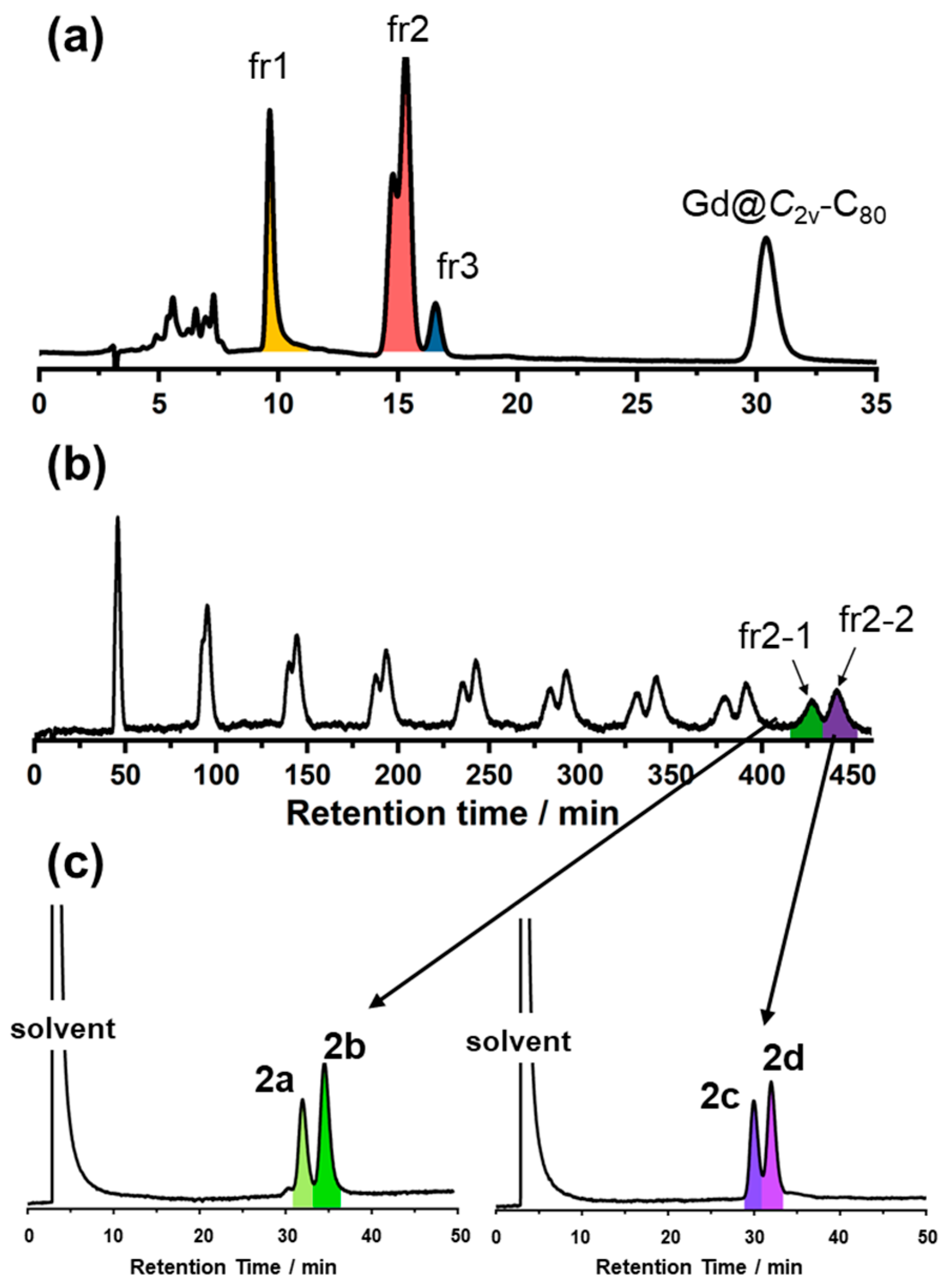

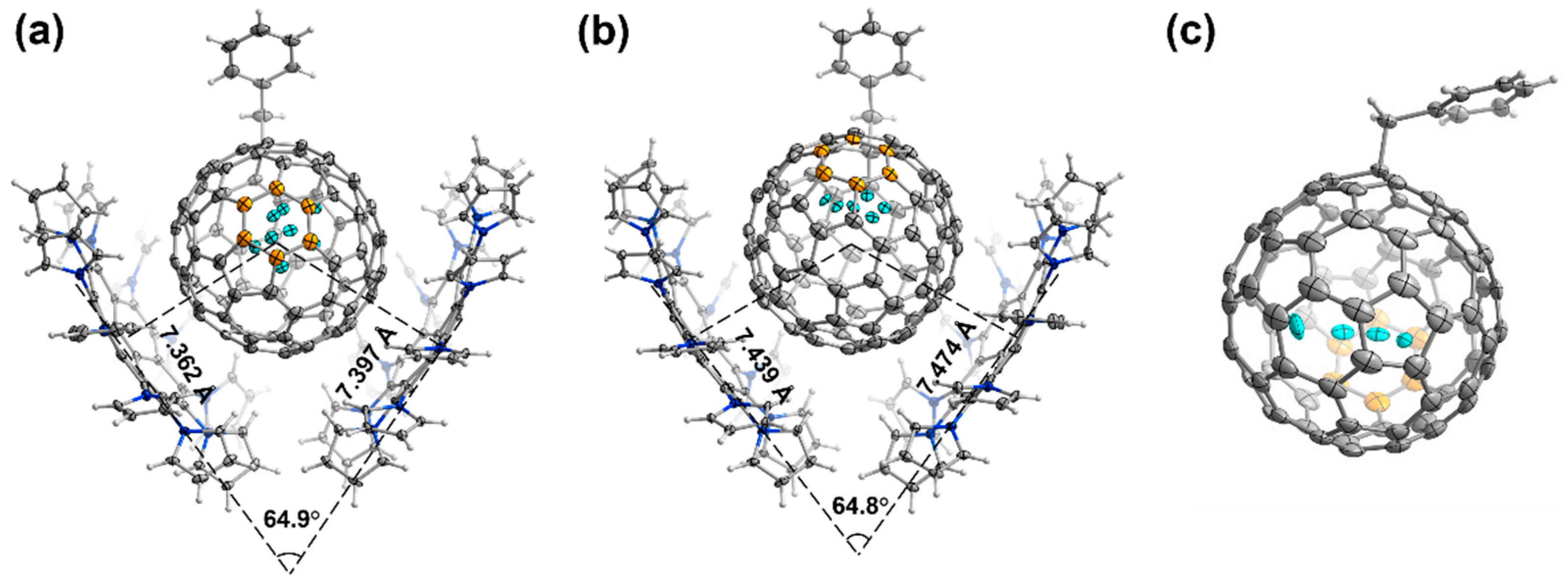
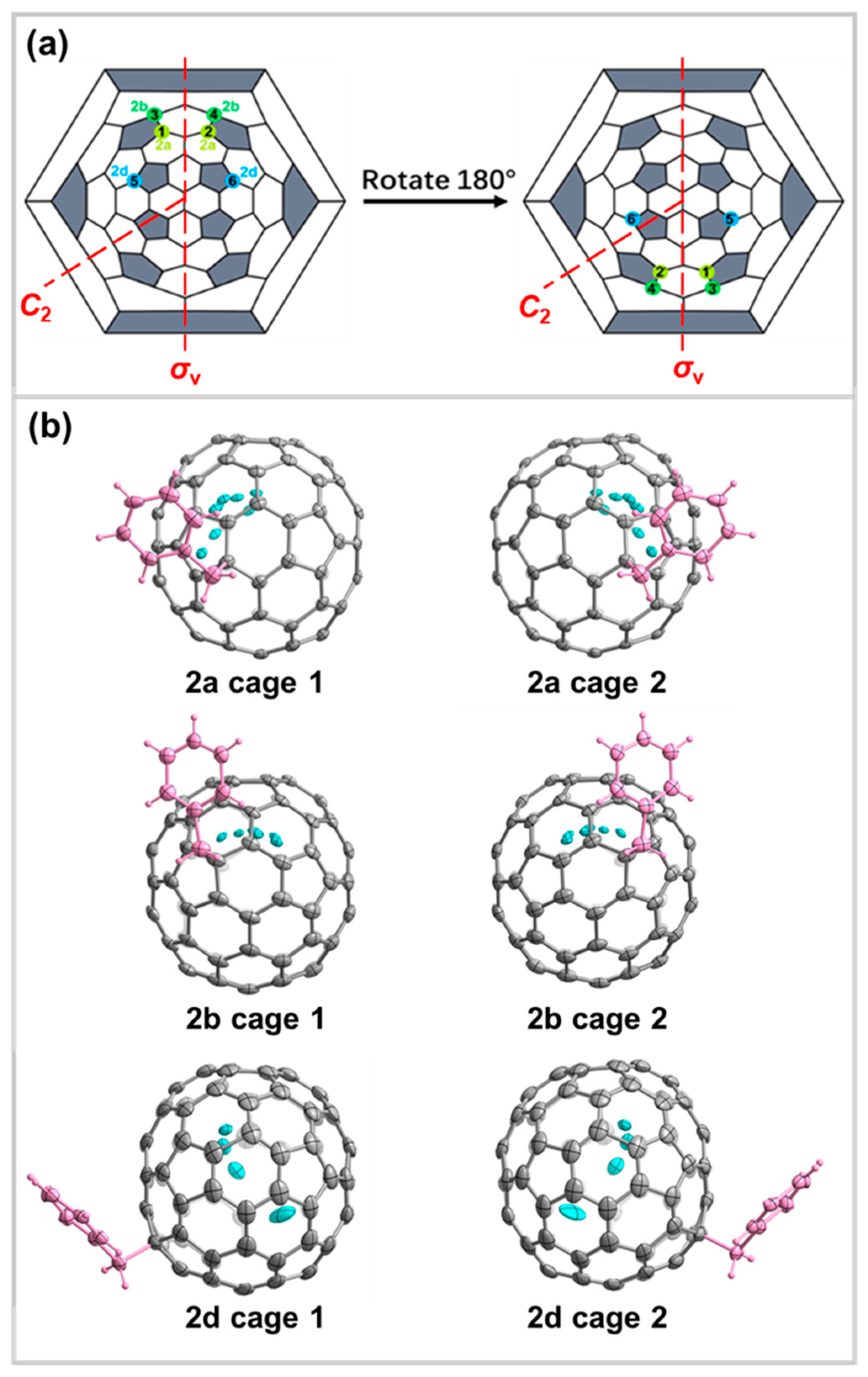
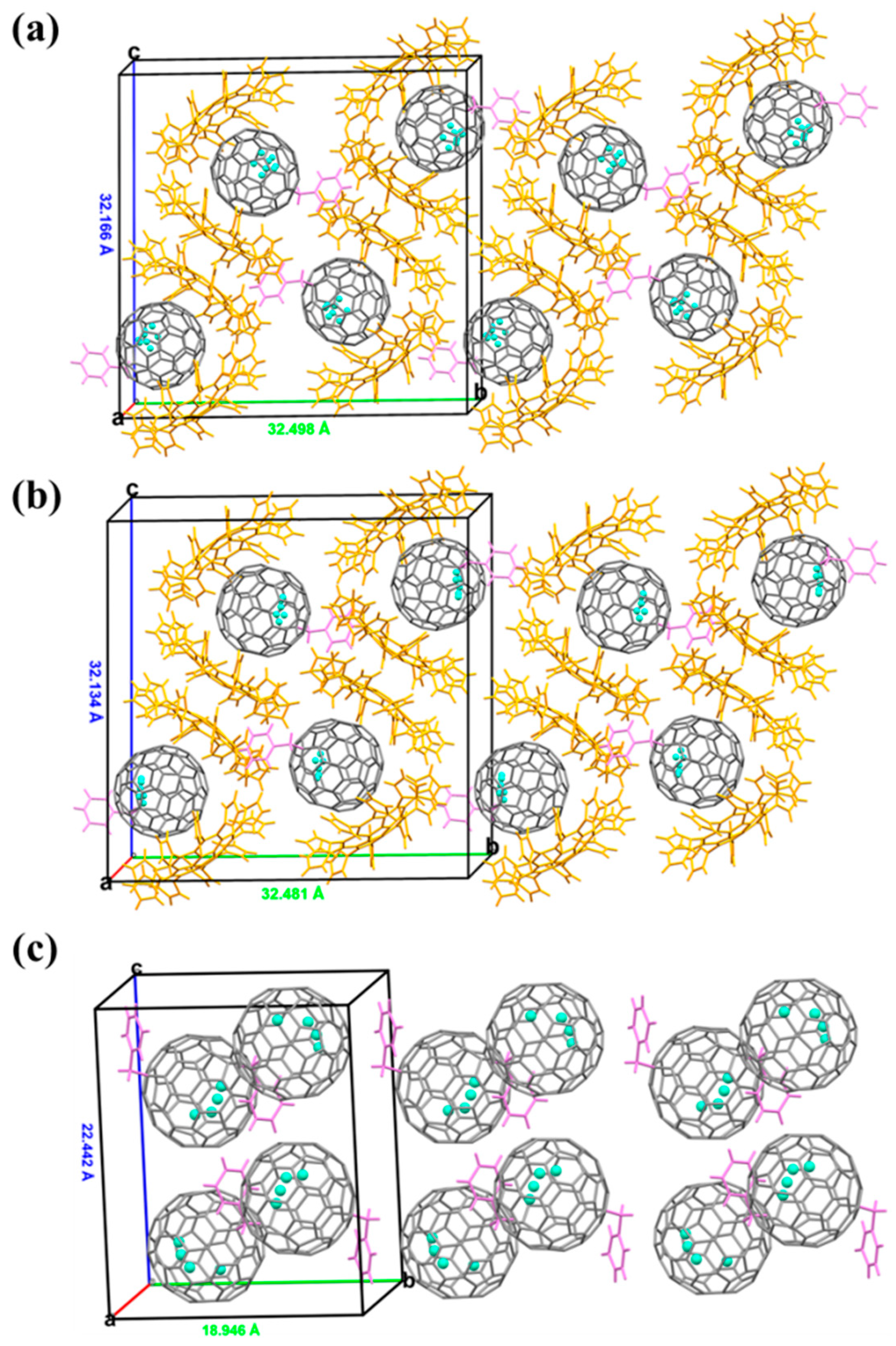
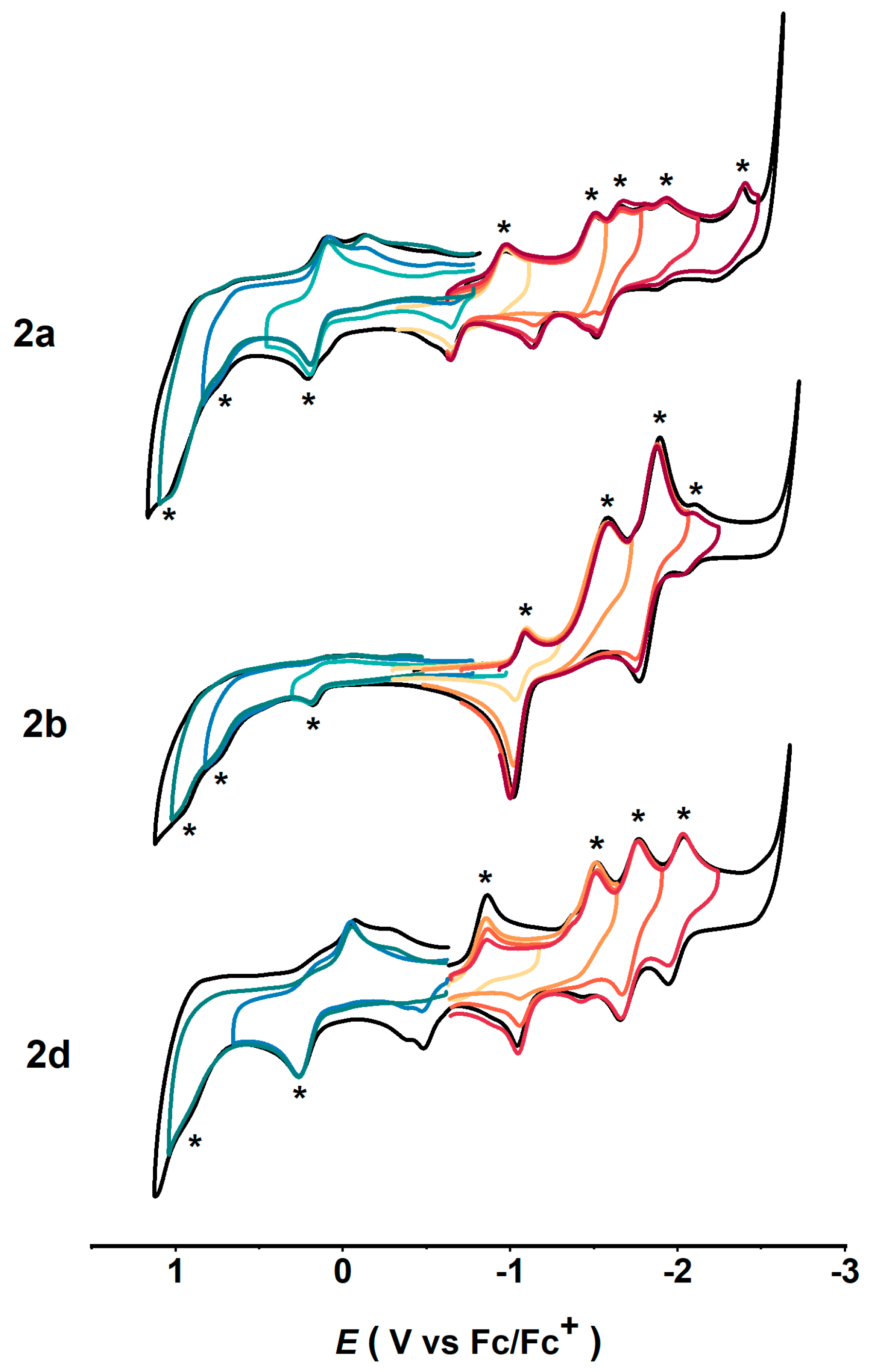


| E2+/3+ | E+/2+ | E0/+ | E0/− | E−/2− | E2−/3− | E3−/4− | E4−/5− | Egap | |
|---|---|---|---|---|---|---|---|---|---|
| Gd@C2v-C82 a | +1.08 b | +0.09 c | −0.39 c | −1.38 c,d | −2.22 b,d | 0.48 | |||
| 2a | +1.03 b | +0.74 b | +0.14 c | −0.97 b | −1.51 b | −1.66 b | −1.93 b | −2.39 b | 1.11 |
| 2b | +0.94 b | +0.73 b | +0.19 b | −1.06 c | −1.58 b | −1.89 c | −2.11 c | 1.25 | |
| 2d | +0.94 b | +0.26 b | −0.86 b | −1.52 b | −1.77 c | −2.04 c | 1.12 |
| M | 6 | 8 | 10 |
|---|---|---|---|
| 2a | 21.0 | 0.0 | 20.9 |
| 2b | 17.0 | 6.8 | 14.9 |
| 2d | 22.1 | 1.8 | 22.2 |
| [Gd@C2v-C82]− | 58.3 | 0.0 | 17.8 |
| [Gd@C2v-C82]3− | 0.0 | 18.3 | 26.7 |
Disclaimer/Publisher’s Note: The statements, opinions and data contained in all publications are solely those of the individual author(s) and contributor(s) and not of MDPI and/or the editor(s). MDPI and/or the editor(s) disclaim responsibility for any injury to people or property resulting from any ideas, methods, instructions or products referred to in the content. |
© 2023 by the authors. Licensee MDPI, Basel, Switzerland. This article is an open access article distributed under the terms and conditions of the Creative Commons Attribution (CC BY) license (https://creativecommons.org/licenses/by/4.0/).
Share and Cite
Zhou, X.; Yao, Y.-R.; Hu, Y.; Yang, L.; Yang, S.; Zhang, Y.; Zhang, Q.; Peng, P.; Jin, P.; Li, F.-F. Reactivity of Open-Shell Metallofullerene Anions: Synthesis, Crystal Structures, and Electrochemical Properties of Benzylated Gd@C2v-C82. Inorganics 2023, 11, 349. https://doi.org/10.3390/inorganics11090349
Zhou X, Yao Y-R, Hu Y, Yang L, Yang S, Zhang Y, Zhang Q, Peng P, Jin P, Li F-F. Reactivity of Open-Shell Metallofullerene Anions: Synthesis, Crystal Structures, and Electrochemical Properties of Benzylated Gd@C2v-C82. Inorganics. 2023; 11(9):349. https://doi.org/10.3390/inorganics11090349
Chicago/Turabian StyleZhou, Xinyi, Yang-Rong Yao, Yajing Hu, Le Yang, Shaoting Yang, Yilu Zhang, Qianyan Zhang, Ping Peng, Peng Jin, and Fang-Fang Li. 2023. "Reactivity of Open-Shell Metallofullerene Anions: Synthesis, Crystal Structures, and Electrochemical Properties of Benzylated Gd@C2v-C82" Inorganics 11, no. 9: 349. https://doi.org/10.3390/inorganics11090349





